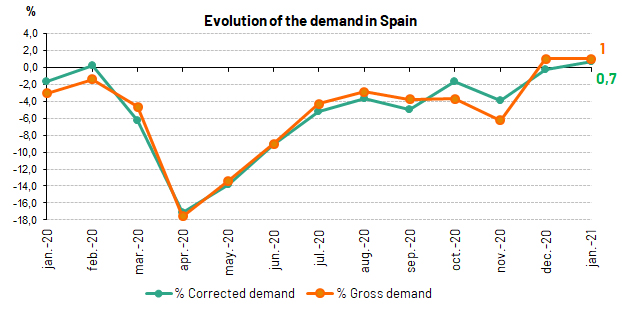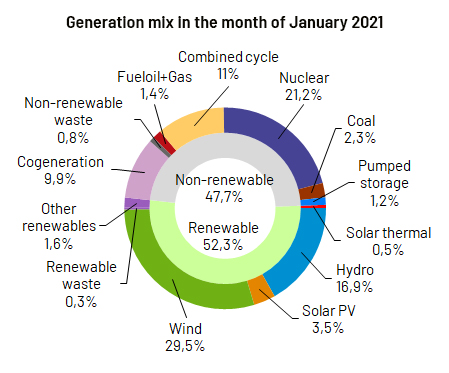For 40 years, we've been driving our country's economic and social progress. Four decades shaping Spain.
Demand for electricity in Spain increases 1% in January
- 52.3% of monthly generation came from renewable sources and 74.7% was produced from technologies that do not emit CO2 emissions.
- Demand for electricity in the Balearic Islands grew by 3.1% and fell by 13.1% in the Canary Islands compared to January 2020.
National electricity demand in January is estimated at 24,074 GWh, a value that is 1% higher than in the same month last year. After having factored in the influence of seasonal and working patterns, demand is 0.7% higher than in January 2020.

In January, and according to data estimated at the time of this press release, generation coming from renewable energy sources represented 52.3% of the total production, registering a value that is 34.9% higher than in January 2020.
Additionally, 74.7% of electricity generation during January was obtained using technologies which produce zero CO2 emissions.
With information available as at the time of this press release, wind energy generation in January reached 7,212 GWh, a figure that is 55.9% higher than in the same period last year, and represented 29.5% of production nationwide, ranking as the leading technology in the generation mix, ahead of nuclear (21.2%) and hydro (16.9%).

Demand for electrical energy in the peninsular electricity system increases by 1.5%
Demand for electrical energy in the peninsular electricity system in the month of January is estimated at 22,907 GWh, a value that is 1.5% higher than that recorded in the same month last year. After having factored in the influence of seasonal and working patterns, the demand for electricity is 1.2% up on that registered in January 2020.
During January, and according to data estimated at the time of this press release, 54.1% of peninsular generation came from renewable energy sources and 77.5% was obtained using technologies which produce zero CO2 emissions. For its part, wind energy stood at 7,129 GWh, 56.1% higher than in January last year, and became the leading technology by contributing 30.5% to the overall generation mix.
Demand for electricity in January grows by 3.1% in the Balearic Islands and decreases by 13.1% in the Canary Islands
In the Balearic Islands, the demand for electricity in January is estimated at 470,639 MWh, a value that is 3.1% higher than that recorded in the same month last year. After factoring in the influence of seasonal and working patterns, the figure stands at a value that is 0.6% lower than in January 2020.
Combined cycle, with 81.3% of the total production in the Balearic Islands, was the leading source of electricity generation. During January, renewable technologies and those which produce zero CO2 emissions accounted for 4.1% of the total generation mix in the archipelago. Furthermore, energy transferred via the Spanish Peninsula-Majorca submarine link contributed to covering 29.4% of the demand in the Balearic Islands.
Regarding the Canary Islands, electricity demand is estimated at 658,120 MWh, 13.1% less than that recorded in January 2020. After factoring in the influence of seasonal and working patterns, the figure stands at a value that is 13% lower than in January 2020.
In January, combined cycle was also the leading technology in the Canary Islands’ generation mix with a contribution of 44.3%. Renewable technologies and those which produce cero CO2 emissions represented 15.2% of the total generation on the Canary Islands.
Consult our Daily Balance Report for more information on the National, Peninsular, Balearic Islands and Canary Islands electricity systems as at the close of January.












